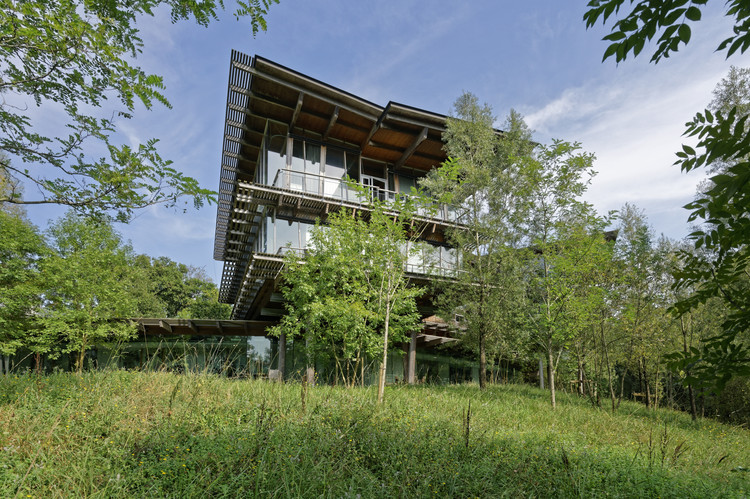Happy Panda Hou de Sousa
2013-08-17 00:00
架构师提供的文本描述。快乐熊猫是位于坎巴亚(厄瓜多尔基多区)的Paseo旧金山购物中心内的一家新餐馆。现有场地为长而窄的鞋盒形体积。我们对客户需求的分析显示,为了更好地为不同的客户类型服务,除了一个更大、更公共的用餐区域外,还需要一个私人餐厅空间。我们把餐位分成两部分,把服务区放在中间。私人空间放在后面,而公共就餐区面向入口。这样做的额外好处是改善了空间的总体比例和感觉,否则的话,空间就会过于紧张和像走廊一样。我们还将厨房提升到阁楼的水平,以便腾出更多的空间来容纳座位和酒吧。
Text description provided by the architects. Happy Panda is a new restaurant located within the Paseo San Francisco shopping center in Cumbaya (a district of Quito, Ecuador). The existing site was a long and narrow shoe box shaped volume. Our analysis of the client’s needs revealed that in order to best serve different customer types, a private dining space was required in addition to a larger and more public dining area. We split the dining space in two by placing the service areas in between. The private space was placed in the back, while the public dining area faces the entrance. This had the added benefit of improving the overall proportions and feel of the space, which otherwise would have been overly stretched and corridor-like. We also raised the kitchen onto a mezzanine level in order to free up more space for seating and a bar.
Courtesy of Hou de Sousa & Jay Vandermeer
工程进度很快,必须采取权宜之计。虽然厄瓜多尔用于小型建筑的资源和材料有限,但该国广告和招牌行业的迅猛发展导致数控机床、激光切割机和大型打印机的激增。在设计项目时,一个关键的优先事项是利用这些技术,以便最大限度地减少对熟练劳动力的需求,并减少施工时间和成本。这一策略在清明节期间以中国卷轴画、清明上河图或沿江为特色的墙壁上最为明显。它最初由张泽端在九百多年前由张泽端所画,后来的几个朝代对它进行了多次重新诠释。我们工作室的敬礼被数字化改造,有选择地裁剪,放大到墙纸的规模,然后由一家广告牌广告公司印刷和安装。
The project schedule was swift, and necessitated expedient methods of construction. While resources and materials for small scale construction is somewhat limited in Ecuador, the dramatic boom of the advertising and signage industries there has lead to a proliferation of CNC machines, laser cutters, and large scale printers. A key priority when designing the project was to make use of these technologies, so as to minimize the need for skilled labor and reduce construction time and cost. This strategy is most evident on the walls featuring the Chinese scroll painting, Qingming Shanghe Tu, or Along the River During the Qingming Festival. Originally painted by Zhang Zeduan during the Song Dynasty over 900 years ago, its acclaim led to many reinterpretations commissioned by subsequent dynasties. Our studio's homage has been digitally altered, selectively cropped, blown up to the scale of wall paper, and then printed and installed by a billboard advertisement company.
Courtesy of Hou de Sousa & Jay Vandermeer
天花板由数控裁剪胶合板和重量级衬布(一种用来加固衣服和西装的织物)组成。胶合板被精确切割,从一组隐藏的钢桁架上安装和悬挂。天花板的形式和它创造的空间是中国寺庙的灵感。我们把这些寺庙的几何学简化成轮廓,然后挤压,然后从质量中减去。通过这一过程,我们将庙宇从其外部视为空间中的物体的状态逆转为居住在由庙宇形态的模式或反面所定义的空间上的条件。天花板是一个连续的表面,平稳过渡之间的高餐厅空间和低服务区。这样,用户就可以在经过餐厅时体验到空间的流动扩展和压缩。
The ceiling is composed of CNC cut plywood and heavyweight interfacing (a fabric used to stiffen dresses and suits). The plywood was precisely cut to fit and suspend from a set of hidden steel trusses. The form of the ceiling and the spaces it creates was inspired by Chinese temples. We simplified and flattened the geometry of these temples into silhouettes, which were extruded and then subtracted from a mass. Through this process, we reversed the condition of viewing a temple from its exterior as an object in space, to that of inhabiting a space defined by the mould or negative of a temple's form. The ceiling is a continuous surface that smoothly transitions between the high dining room spaces and the low service area. This allows users to experience a fluid expansion and compression of space as they walk through the restaurant.
Courtesy of Hou de Sousa & Jay Vandermeer
中国传统设计的影响也小得多。我们修改了一个波浪图案,这是典型的发现在中国釉陶器,成为一个极阵列的点。利用各种材料和技术,这一模式适应了几个目的。在展位之间,有白色的丙烯酸隐私屏幕,其中有激光切割出来的点。这些洞足够大,屏幕另一边的人的形象是明显的,但足够小,他们的特征和身份是模糊的。在发光的表面,点状图案提供一个色调的对比和投下微弱的阴影。在私人房间里,墙内衬着中密度纤维板,用数控路由器穿孔超过50,000次,刻有深度和纹理的图形图案。
The influence of traditional Chinese design is also present at a much smaller scale. We modified a wave pattern, which is typically found on Chinese glazed pottery, into a polar array of dots. Making use of a variety of materials and techniques, the pattern was adapted to several purposes. Between booths, there are white acrylic privacy screens with the dots laser cut out of them. The holes are large enough that the figures of people on the other side of a screen are noticeable but small enough that their features and identities are obscured. On the glowing surface of the bar, the dot pattern provides a tonal contrast and casts faint shadows. In the private room, a wall is lined with MDF panels that were perforated with a CNC router over 50,000 times to carve a graphic pattern with depth and texture.
Courtesy of Hou de Sousa & Jay Vandermeer
我们的目标是让餐厅变得温暖、诱人,从某种意义上说,就是失重。LED是沿着天花板的边缘使用,在视觉上把它从墙壁上分离出来。吊顶下面的钢桁架是完全隐藏的。这样做的目的是让天花板看起来像一块被向上挤压的布料,在天花板下面留下一个空间。一个点网格的定制照明装置浮在天花板以下的铬管。内建的摊位和桌子是详细的,使他们似乎悬停在离地面。
We aimed for the restaurant to be warm, inviting, and in a sense, weightless. LEDs were used along the edges of the ceiling to visually detach it from the walls. The steel trusses that suspend the ceiling below it are completely hidden. The intention was for the ceiling to appear as light as a sheet of fabric that has been pinched upwards to create a space below it. A point grid of custom lighting fixtures floats below the ceiling on chrome pipes. The built in booths and tables are detailed so that they appear to hover off the floor.
 举报
举报
别默默的看了,快登录帮我评论一下吧!:)
注册
登录
更多评论
相关文章
-

描边风设计中,最容易犯的8种问题分析
2018年走过了四分之一,LOGO设计趋势也清晰了LOGO设计
-

描边风设计中,最容易犯的8种问题分析
2018年走过了四分之一,LOGO设计趋势也清晰了LOGO设计
-

描边风设计中,最容易犯的8种问题分析
2018年走过了四分之一,LOGO设计趋势也清晰了LOGO设计








.jpg)















































.jpg)




















.jpg)








